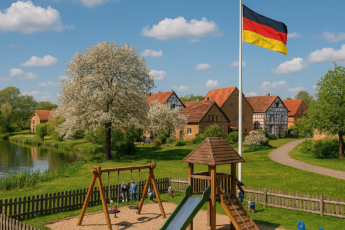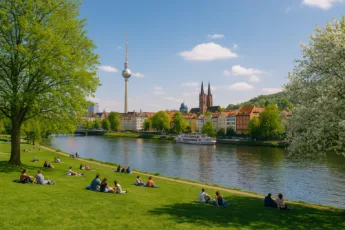German cuisine has been underestimated for years. When we talk about Europe's culinary powers, we usually think about France, Italy or Spain. Meanwhile, Germany has its culinary identity - a vast, diverse and rooted in tradition. What's more, it is a country that is not afraid of modernization - classic dishes live here next to vegan, fusion and street food from around the world. Food in Germany is a fascinating journey - and you don't have to have a pork knuckle in a hand.
There is no such thing as one "German cuisine". It is rather a cluster of flavors from various trade union countries - and each of them has their own specialties. It's like comparing dumplings from Podlasie with highlander Kwaśnica - both Polish, but completely different. In Bavaria, wheat beers and pretzels reign, in the north - fish from the North Sea, and in the eastern lands - venison and sauerkraut. It is worth knowing before traveling - not to look for Matias in Munich.
You can't hide: sausage is present. And beer is poured with a wide stream. But at the same time in Germany we will eat one of the best breads in Europe, soups with a surprising wealth of taste and desserts that can embarrass the Vienna confectionery. German cuisine is a balance between satiety and taste - the food is not only to fill the stomach, but also enjoy. Contrary to appearances, Germany is gourmets - they just don't talk about it with such enthusiasm as Italians.
🍽️ Daily meals of a German - what, when and how?
Breakfast in German: Bajgiel? No, Brötchen
Breakfast in Germany is time for ... a roll. And actually Brötchen - crunchy on the top, soft inside. Plus butter, cheese, sausage, jam or honey. Cooked eggs and muesli yogurt are also popular. Interestingly, Germans rarely drink tea - coffee reigns, preferably from the espresso machine, served without milk or with a little cream. Breakfast is usually a homemade, calm, but not very long - the working day begins early.
Lunch? Only with potatoes
In Germany, a traditional dinner is a hot dish, usually consumed between 12:00 and 14:00. Although it is increasingly being replaced by lunchbox at work, dinner is still in many homes. Meat reigns: pork loin, stew, baking - always with potatoes, noodles or dumplings. Vegetables? Cooked carrots, cabbage, beets - all like "al dente differently". Soups - although not as popular as in Poland - also appear: goulash, potato, beef broth with pasta.
Brotzeit - dinner other than all
Dinner in Germany is usually something light. Although it sounds like dinner - it is the opposite of the Polish evening feast. Brotzeit dominates here - "bread time". In practice: slices of rye bread, cottage cheese, sausage, potato salads and pickled cucumbers. The meal is fast, simple and practical. And - what is important - often consumed in silence, without a ritual of family feasting. Non -alcoholic beers, sparkling water or apfelschorle - apple juice diluted with water also reign on the table.
What between meals? Snack on the way
Germany does not celebrate afternoon tea, but the snacks are present at them. And it's like! At work - often yogurt or fruit. At school - bread with cheese or kabanos. On the street - a precel, a roll with sausage or a piece of pizza. Sweet snacks are also popular - leibniz cookies, small Berliner donuts and chocolate bars. The snack is fast, specific and preferably ... cheap.
What do Germany drink? Not only beer
Although Germany is famous for his beer, coffee reigns - black, strong, without additions. Water with bubbles (Sprudel) is an absolute norm, and juices are often diluted - to make it healthier. Club-Mate is also popular -a cult drink with caffeine, known especially in Berlin. In homes, we will also often find fruit teas, and restaurants-Fritz-Kola or Spezi (cola with orange). Drinks in Germany are a separate ritual - and often surprise more than main dishes.
How to behave at the German table?
The rules are simple: punctuality, order and lack of spilling of soup. Germany does not like to waste food - to this day the saying: "Whoever does not eat will not grow." Tips in restaurants are 5-10%, and loud conversations at the table are badly seen. Cut the bread and do not bite, and put the cutlery evenly on a plate after a meal. Interestingly, Germany rarely invite strangers home to food - a restaurant is a social space.
🌍 The flavors of regions - culinary division of Germany
Bavarian kitchen: pork knuckle, pretzels and beer
When we say "Bavaria", we think: Oktoberfest, beer and pork knuckle. And rightly! Bavarian cuisine is a feast for lovers of heavy, full -bodied dishes. Schweinshaxe (baked pork knuckle in beer), Weißwurst - white sausage eaten before noon with mustard and pretzel reigns on the tables . All this washed with local wheat beer. In this part of Germany, a meal is a ritual, not just a necessity.
Saxony and Thuringia: noodles, soups and sausages
Eastern Germany serves more "homely" cuisine - with a great influence of rural and Czech traditions. Thüringer Rostbratwurst is the famous Turin grilled sausage, available at every market. Klöße are popular in Saxony - large potato noodles, often served with roasting and red cabbage. The soups are thick and specific here-e.g. Soljanka , a Russian-German variation on a spicy soup with meat and vegetables. Strong, greasy flavors, but fair.
Berlin: The capital of flavors from around the world
In Berlin, German cuisine meets Turkey, Syria, Vietnam and Israel. Döner Kebab was born in the German form - with crispy roll, fresh vegetables and yogurt sauce. Currywurst - sausage with ketchup curry, obligatory on every street is also popular In the capital you will also find restaurants serving dumplings, pho, hummus and ramen. This is not so much "German cuisine" as a show of German culinary tolerance.
Rhine and Palatinate: wine, asparagus and Flambchen
Lighter flavors dominate in the Moselle and Rena region. It is a land of white wine, blue cheese and thin baking. Flammkuchen is a local version of the pizza - a thin cake with onions, bacon and cream. white asparagus reigns - cooked with butter, served with potatoes and eggs. Despite the closeness of France, the kitchen is very local here - calm, seasonal, aromatic.
Hamburg and North: Herring, fish and marinades
North of Germany lives by sea. In the menu you will find Matjesa - a young herring in vinegar, Fischbrötchen - a roll with fish, onions and cucumber, and fried fillets from cod and mintia. Hamburg is a mecca of fishing, and the port kitchen attracts gourmets from around the world. Here we will also find influence of Scandinavia and the Netherlands - silage, marinades, dark bread and sharp mustard. Whoever does not like fish will have hard.
Sweet Saxony: Cheesecakes, cakes and Christmas baked goods
Saxony is famous for his sweets. This is where Dresdner Stollen - a Christmas cake with dried fruit, candied skin and powdered sugar. Eierschecke is also popular - a three -layer cake with pudding, cheese and sponge cake. Saxonians love coffee and cake - a daily afternoon ritual, called Kaffeetrink . This is a place where dessert can be more important than dinner.
🛒 Food products and shopping in Germany
German supermarket - order, quality and cheap butter
Shopping in Germany is pure pleasure (literally). Shops are logically ordered, well -stocked, and products are often cheaper than in Poland. Depending on the region, you will most often meet Lidl , REWE , Edeka and Aldi . Lidl and Aldi are budget options, with good bread and cheap cheese. Rewe and Edeka are a "average shelf" - more local and bio products, but also higher prices. It is also worth visiting DM drugstores - there you can buy great BIO food products.
What to buy in a German store - list of classics
- Bread: over 300 types - especially Vollkornbrot (whole grain) and Roggenbrot (rye)
- Cheese: Allgäuer Emmentaler , Butterkäse , Cambozola
- Crains: Leberwurst , Schinken , Salami with garlic
- Sweets: Ritter Sport , Haribo , Bahlsen
- Drinks: Apfelschorle , Club Mate , Kraft beers
It is these products that are most often bought by tourists - whether as souvenirs or fast provisions on the go.
German bread - bread that is full and addictive
Bread in Germany is a separate cultural category. The breads are dark, heavy, sour - and really nutritious. Pumpernickel , rye bread with nuts , whole grain sesame - all available in a cut, vacuum packed or fresh bakery version. Small rolls are also popular: Brötchen , Roggenbrötchen or Kürbisern (with pumpkin seeds). Bread with butter and cheese is a German classic for every time of the day.
Cheese, cold cuts and yogurt - German cooled paradise
In the refrigerators of German stores you will find dozens of types of cheese: from delicate butterkäse , through camembert , to strong mold. Cold meats? Thinly cut ham and intense pies with pepper or herbs. Germans also love yogurt - thick, cream, with or without sugar. The popular brand is Alnatura - BIO, locally and tasty. Interestingly - yogurts are often cheaper than mineral water.
Table: Sample prices of food products in Germany
| Product | Brand / type | Sample price (EUR) | Where to buy |
|---|---|---|---|
| Butter (250 g) | Milsani, Kerrygold | 1,79 – 2,29 | Lidl, Rew, Edeka |
| Rye bread (500 g) | Vollkornbrot | 1,50 – 2,50 | Bakery, Aldi, Rewy |
| Cottage cheese (200 g) | Exquisa, Alnatura | 0,79 – 1,49 | DM, Edeka |
| Apple juice (1 L) | Apfelsft Klar | 0,99 – 1,39 | Lidl, net |
| Natural yogurt (500 g) | Müller, Gut & Günstig | 0,69 – 0,99 | Rewe, Edeka |
| Haribo (175 g) | Goldbären | 0,85 – 1,29 | Kaufland, Rossmann |
BIO and EKO: Germans love nature on a plate
BIO products in Germany are not a luxury, but a norm. You will find them not only in specialized stores like Alnatura , but also in regular supermarkets. BIO and Demeter markings guarantee high quality, lack of pesticides and often local origin. Germany is very ecologically aware - even in discount stores you will find vegetables
🧆 street food and fast food in German
Currywurst - National Street Food Germany
This is not a legend - Currywurst really eats tons here. The classic version is a chopped grilled sausage poured with tomato sauce with curry spice, often served with fries and mayonnaise. You will find it everywhere - at stations, in booths, in shopping centers. the Currywurst Museum operates in Berlin . Price? From 3 to 5 euros. This is a perfect example of German street food: fast, cheap, filling and without unnecessary sophistication.
Döner Kebab - a dish that revolutionized the German street
Invented by the Turkish immigrant in Berlin in the 70s, Döner Kebab is almost a national dish today. A roll or cake filled with grate meat, vegetables and sauce (usually garlic or yogurt). In the veg version - with cheese or falafel. Germans eat him for lunch, dinner, and often also "after a party". One portion costs from 4 to 6 euros. Fun fact: more kebabs are sold in Germany than all over Turkey!
Fischbrötchen - herring, onion and roll
In the north, especially in Hamburg, Fischbrötchen - a roll with marinated herring, onion, lettuce and cucumber. This is a quick fish snack that can be obtained in port bars, at stations and small booths. Specific taste, but freshness does its job. It's food that you either love or hate - but you have to try. Prices: 3.50-4.50 euros.
What instead of McDonald's? German fast food alternative
- Nordsee - Fast Food network with fish and seafood
- Backwerk - self -service bakery with sandwiches and pizza
- Curry36 - Berlin Cult Budka with Currywurst
- Hans im glück -Gourmet-Burgers in a German style
Although McDonald's and Burger King are present, Germany willingly choose local alternatives. Cheap, fresh and often more filling - especially when it comes to fish, bread and kebabs. Additional plus: many places offer vegetarian and vegan options.
Table: Popular street food in Germany and prices
| Dish | Composition | Typical location | Price (EUR) |
|---|---|---|---|
| Currywurst with fries | Sausage, curry sauce, fries | Booth, station, center | 3,50 – 5,00 |
| Döner Kebab | Meat, vegetables, sauce, roll | Kebabownia, street, Foodtruck | 4,00 – 6,00 |
| Fischbrötchen | Herring, onions, lettuce, roll | Port, station, Rybna Budka | 3,00 – 4,50 |
| Pretzel with butter | Salty precel, butter | Bakery, station, backwerk | 1,20 – 2,00 |
🍰 Desserts, cakes and sweets
Black legend - Blackhead cake
Schwarzwälder Kirschtorte , or the Black Forest cake, is an icon of German confectionery. Chocolate countertops, whipped cream, cherries and a bit of Kirsch (cherry brandy) - it all creates an intense but elegant dessert. Served for special occasions, although also available in confectioneries and cafes. He comes from the Schwarzwald region, but is known all over the country. The price of the piece: 3.50-4.50 EUR. Note: Real contains alcohol!
Cheesecakes that Krakow would not be ashamed of
Although Germany does not have a "one" classic cheesecake, their käsekchen beats popularity records. Light, fluffy, often on the bottom of shortbread. It comes in a version with raisins, peaches and even poppy seeds. Rarely with icing - Germany prefer simplicity. Also try Quarkuchen - with a delicate quark cheese. Best: in small, family confectioneries. Price: approx. 3 EUR for a solid piece.
Apfelstrudel - not only in Austria
Although the roots of this dessert reach Vienna, the Germans love him. Apfelstrudel is a wrapped cake with apples, cinnamon and raisins, sometimes served hot with ice cream or whipped cream. Particularly popular in Bavaria and the south of the country. It is a dessert that tastes good in summer and winter - and does not require a great opportunity. Price: EUR 2.50–4, depending on the add -ons.
List of the most popular sweets in the German store
- Ritter Sport - chocolate in square plates
- Haribo - jelly beans, teddy bears, sour snakes, foams
- Milka and Kinder -though Austrian/German-Italian, very popular
- Bahlsen - cookies, biscuits, gingerbread
- TofFifee - Caramel nut with chocolate
Sweets in Germany are cheap and available almost everywhere. Many of them are export products - and great travel souvenirs.
Table: Popular German desserts and cakes
| Name | Type | Ingredients | Sample price (EUR) |
|---|---|---|---|
| Schwarzwälder kirschtorte | Cake | Chocolate, cherries, whipped cream, alcohol | 3,50 – 4,50 |
| Käsekchen | Cheesecake | Quark, eggs, shortcake | 2,50 – 3,50 |
| Apfelstrudel | Strudel | Cake, apples, cinnamon, raisins | 2,00 – 4,00 |
| Eierschecke | Layered cake | Sponge cake, pudding mass, cheese | 2,50 – 3,00 |
🍺 drinks - from beer to regional inventions
Beer in German - culture, not only percentages
In Germany, beer is not a drink - it is a tradition. Each region has its own breweries and pride in local flavors. The most popular styles are Helles (bright), Weißbier (wheat) and pils (slightly hop). In Bavaria, mandatory with foam, in bottles with a porcelain cap. Beer is drunk in moderation, but often - at dinner, at the festival, at the grill. There is no culture of "drinking" here, rather celebration of taste. Prices in the store: from 0.80 to EUR 1.50 per bottle 0.5 l.
Glühwein and other mulled classics
Glühwein reigns in winter - mulled wine with spices, often with the addition of orange or rum. Sold on Christmas markets in decorative cups that can be stopped (or returned and regaining deposit). In wine regions you can find a Winzer-Glühwein -a craft version. Feuerzangenbowle is also popular - cane sugar soaked with rum set on wine. Climate and taste - unforgettable.
Wine from Mosel and Rhine - German elegance
Germany is the third largest wine producer in Europe. Particularly famous are white, semi -dry riesling from the Moseli and Rhine Valley. Wine is not elite here - you can buy it in any store from 3 EUR above. Apfelwein (apple wine) in Hesse and Spätburgunder (red pinot noir) in Baden are also popular Wine is drunk for dinner or as an aperitif - often in chilled and diluted version.
Club Mate, Fritz-Kola and other German strangeness
Germany is also inventors of drinks on the border of hipster culture. Club Mate - a drink based on Yerba Mate with caffeine - this is the legend of Berlin youth. Fritz-Kola is a response to Coca-Cola: less sweet, more stimulating. In addition, bionade - an organic alternative to lemonade. In each store you will also find Apfelschorle - apple juice mixed with sparkling water - a healthy and popular choice for dinner.
Table: Popular drinks in Germany
| Name | Type | Description | Price (EUR) |
|---|---|---|---|
| Weißbier | Wheat beer | Cloudy, light, often from Bavaria | 0,90 – 1,50 |
| Riesling | White wine | Semi -dry, fruity, from Moselle | 3,00 – 8,00 |
| Glühwein | Mulled wine | With spices and citrus, on fairs | 3,00 – 4,50 |
| Club Mate | Drink with caffeine | Based on Yerba, iconic in Berlin | 1,00 – 1,80 |
| Apfelschorle | Soft drink | Apple juice with sparkling water | 0,70 – 1,20 |
›Occasional food - Holidays and traditions
What do Germans eat at Christmas?
Christmas in Germany is a feast - but different than in Poland. goose or duck reigns , served with red cabbage and noodles. In many homes we will also meet Kartoffelsalat Mit Würstchen - potato salad with sausages (!), Eaten on December 24. The dessert is stollen - heavy yeast dough with dried fruit and powdered sugar. Although Christmas is not preceded by a post, Germany greatly celebrates dinner and family feast.
Easter sweet and spring
Easter in Germany is a light kitchen: stuffed eggs , asparagus , baked pork loin , and for dessert cakes with marzipan and classic oserlamm - lamb -shaped cake, sprinkled with powdered sugar. Hefezopf is also baked in many regions - a sweet yeast braid. Although Germany is not very religious, Easter breakfast with eggs, horseradish and sausage is a duty in many homes.
Oktoberfest - not only beer festival
The famous Oktoberfest in Munich is not only a beer in liter mugs - it's also food. The tables are reigned by Hendl (baked chicken), Weißwurst (white sausage), Pretzle and Obatzda (cheese paste). Meals are caloric but thought out - they blend in perfectly with alcohol and hours of celebration. And there are classic cakes and beer desserts, e.g. Apfelküchle - apples in dough.
Christmas markets - the taste and smell of winter
Food rules on German Weihnachtsmarkts Most often: grilled bratwurst raclette - melted cheese on potatoes, lebkuchen (gingerbread), almonds in caramel and of course mulled wine . Portions are large, varied prices (EUR 2-8), and the climate is unique. Food is served on paper trays or in decorative cups with the possibility of purchase.
Table: Occasional food in Germany
| Opportunity | Dish | Description | Price (EUR) |
|---|---|---|---|
| Christmas | Goose / Stollen roast | Main dish + Christmas dessert with dried fruit | 8 – 14 / 5 – 7 |
| Easter | Osterlamm / Hefezopf | Lamb -shaped cake / sweet braid | 3 – 5 |
| Oktoberfest | Hendl / Pretzel | Roasted chicken, precel with mustard | 7 – 12 / 2 – 4 |
| Christmas market | Bratwurst / Glühwein | Grilled sausage, mulled wine in a cup | 3 – 5 / 3 – 4,50 |
🎒 For tourists - practical culinary advice
How much does food cost in Germany? Comparative table
| Type of meal | Place | Price range (EUR) | Example |
|---|---|---|---|
| Breakfast | Piekarnia / Cafe | 3 – 7 | Brötchen + coffee + yogurt |
| Lunch | Fast food / kebab / canteen | 4 – 8 | Currywurst with fries / Döner |
| Lunch / dinner | Mid -range restaurant | 12 – 18 | Schnitzel + potatoes + beer |
| Cooked alone | Supermarket | 5 – 10 | Products for 2 people (1 meal) |
What is worth trying and what is better to avoid
- Try: local sausages (Thüringer, Nürnberger), regional cheese, bread from the market, fish in Hamburg, Apfelstrudel, Stollen
- Avoid: "for tourists" dishes in city centers - often more expensive and less authentic
- Note: Not every place offers the English menu - it is worth knowing some basic names of the dishes
German restaurant - how to find yourself?
In a German restaurant you usually sit where you want (unless the table is reserved - then there will be a "Reserviert" card). The service approaches quickly but does not always speak English. Dishes are brought in turn, the bill must be asked. We give the tip (5-10%) in cash or add it for card payment - it is not left on the table. Also remember that tap water is rare - you are usually served bottled (and costs!).
Vegetarian in Germany - it's not bad!
Although German cuisine is associated with meat, this country is surprisingly friendly for vegetarians. In the restaurants you will find meatless dishes: flammkuchen with vegetables , spätzle with cheese , noodles with cabbage , vegetable soups and lots of salads. In supermarkets separate shelves with Vegan and Vegetarisch . There are also fully vegetarian restaurants in Berlin, Leipzig and Munich, and plant options in fast food are already the norm.
What to eat quickly - proven options for busy people
You don't have time for a long meal? Come to Backwerk , Kamps or Le Crobag - bakery networks offering sandwiches, salads and hot pizza. At railway stations, it is worth looking for curry and pretzli . For a cheap and concentrated meal - a kebabownia or Asia Imbiss (fast Chinese style dishes). Snack + drink = approx. 5–6 EUR.
Typical mistakes of tourists - what not to do
- Don't try to enter the restaurant 5 minutes before closing - Germany doesn't like it
- Don't say "Tap Water, Please" - they will propose bottled and count
- Don't leave a tip on the table - give it to the waiter
- Do not assume that card payment is everywhere - cash is still popular
Applications and tips at the end
Do you want to eat cheap and good? Install the Too Good to Go - German restaurants and bakeries sell unsold food there for pennies (2-4 EUR). Also check Google Maps with opinions - German users are detailed and honest. If you want something local - ask about Mittagsmenü (dinner set at a promotional price, available only at lunchtime). And if you find a street market - buy a pretzel and apple juice. It won't be tastier!
✅ Summary: German food without stereotypes
When we say "German cuisine", many can only imagine sausage, cabbage and beer. But as this guide showed - food in Germany is much more : local flavors, regional diversity, high -quality products, fantastic pastries and rich food culture. Regardless of whether you are a fan of meat dishes, a vegetarian, a gourmet of bread or a lover of sweets - in Germany you will find something for yourself.
Daily meals are practical and tasty at the same time. Street food - filling and cheap. Desserts - worthy of confectionery masters. And drinks? From classics to inventions that conquer the hearts of young generations. On holidays and at fairs, the Germans show a culinary soul, and in shops and fairs - everyday quality.
Traveling through German flavors is not only a culinary but also cultural experience . That is why it is worth approaching her with an open head, curiosity and ... an empty stomach. Because, as the Germans say - Liebe Geht Durch den Magen , or "Love goes through the stomach."
Tasty - GUTEN APPETIT!







